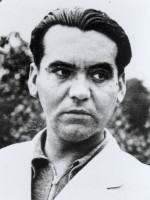
|
Beate Hein Bennett
January 31 – February 16, 2025 Federico Garcia Lorca (1899-1936), one of Spain’s
most renowned 20th century playwrights and poets, left at his death
by execution during the Spanish Civil War a body of dramatic work
that resonates with intensity to this day, albeit his work is too
rarely seen on stage in this country. And so it should be much appreciated
that two young ensembles are presenting a bi-lingual version of
Lorca’s powerful tragedy “Blood Wedding.” Director
and Adaptor Celeste Moratti (Founding Director of First Maria Ensemble)
has brought together an international ensemble of young actors from
Argentina, Italy, Poland, Colombia, Venezuela, Armenia, the Netherlands,
and the USA, all of whom have made their home here in New York and
perform this highly poetic play that plumbs the very depth of the
human soul. Lorca created a text that oscillates between the
harsh reality of rural life in the arid plains of Spain among people
bound to strict traditions and the archetypes of deep passions that
suffuse human experience. This tension between the seen and the
unseen, between passion and propriety, between freedom and safety,
between life and death, is at the core of Lorca’s drama. In
a lecture given in Buenos Aires in 1933, he speaks about the Spanish
concept of “Duende” by which he means a deep emotive
force that imbues creative work with the power to affect the performance
of the work. As an artist native to Andalusia, he identifies with
this profound force as experienced in the “canto jondo”
of Flamenco musicians and dancers and which he equates with the
Dionysian spirit as expressed in the choric sections of the ancient
Greek tragedies. The poetic power of Lorca’s three tragedies—Yerma
(1934), The House of Bernarda Alba (1936), and Blood Wedding (1933)--
resonates in the choruses and music interfacing the actions of the
individual characters. The performance of “Bodas de Blood”
at Teatro Circulo, located next to LaMama, the foremost international
theater institution in New York City, bristles with electricity.
Alternating English with Spanish unlocks the sensual aspect of Lorca’s
poesy. Accompanied throughout with varying percussive rhythms, composed
and played by Francesco SantaLucia and Papaceccio, the actors move
with ease from one mode of performance as individual characters--some
playing multiple roles-- to being a member of the choral community
of women. Movement Director and Choreographer Sandro Isaack devised
tightly controlled patterns that support the highly rhythmic choral
sections. Three male characters represent the competitive
traditional male aspect of rural society: the Young Man who must
find the right bride (preferably with means and a good name) to
beget the necessary off-spring; the Father of girls who must find
the right bridegroom (preferably with a good name and means) for
his girls; and the untamable young roving man, the archetypal Lover,
who becomes the catalyst of the tragedy that befalls the small community.
Michal Walentynowicz plays the Bridegroom with innocent charm. Leonardo,
his competitor/antagonist, an unhappy and impecunious young man,
is played with a sharp undercurrent of violence by Ryan Schaefer.
The Father of the Bride, a struggling landowner in the arid highlands,
is played by Hraban Luyat with an ingratiating sense of practical
efficiency. A central character is the Mother of the Bridegroom
who has lost her husband and a son to violence, as she puts it:
with the “little” knife that cuts life in an instant
at “the dark root of the scream.” Eric Alexander plays
the Mother of the Bridegroom with an uncanny sense of a woman who
is bereft but masters her sorrow; the actor’s eyes and hands
carry a wide range of emotions, his tall proud comportment shows
a capable woman with feet firmly planted in reality. Carmen Ezcurra
embodies the very young Bride who is torn between the two men—one
proper and safe, the other wild with cold heat-- and deep down she
also desires to be free from all constraints. Stephanie del Bino
is Leonardo’s suffering wife and mother of their baby boy,
shunned and betrayed by Leonardo. Her Mother-in-Law is played by
Celeste Moratti, the director and adaptor of “Bodas del Blood.”
Other ensemble members, Betty Amelia, Meg Siepak, and Cecilia Wisky
(Co-Director and Co- Founder of Camabalache) play variously a Maid
and neighbor women, and in the surreal forest scene of the final
act, they play various mysterious characters. Of special note among
the female characters is the Beggar Woman/ Death (La Muerta) played
hauntingly by Ana Ordonez: in the final scene of the play she metamorphoses
from the crippled disjointed beggar woman of the forest to the erect
spiderlike La Muerta in the center of her red net spread across
the stage. Last not least, I wish to comment on the inventive
coordinated designs of space and costumes by Raffaella Toni. Sturdy
boxes made with simple materials can be moved by the actors as needed
to create different spatial configurations. The costumes for the
entire ensemble are made of natural or white cotton muslin and cut
in a variety of ways with added shawls or belts where indicated.
Danilo Facco’s lighting design creates atmosphere and focus,
a challenge in this fast moving production. Teatro Circulo is a
fine performance space for intimate plays in which the close encounter
with human passions and expression is of essence. |
| recordings | coupons | publications | classified |

